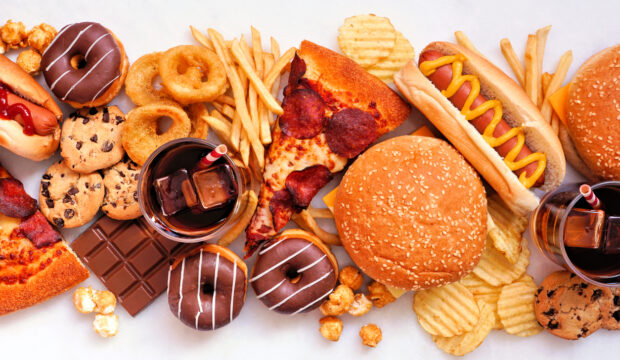Introduction
Have you ever heard the term “Food Noise”?
It does not simply refer to hunger or an empty stomach, but rather a persistent and repeated urge or craving for food.
Constantly thinking about food, being unable to get it off your mind—these experiences can significantly impair your quality of life.
“Food Noise” has become a very important keyword for understanding today’s obesity problem.
Mechanism Behind Food Noise
Why does Food Noise occur? When exposed to continuous food-related stimuli in daily life—such as enticing images of delicious meals or the aroma of food—our brains can become overly responsive.
Modern society provides abundant stimuli: social media packed with food content, convenience stores and restaurants where food is easily accessible, and more. Such an environment triggers Food Noise frequently.
Difference Between “Food Noise” and “Food Craving”
A commonly confused concept is “Food Craving”, which refers to a temporary, intense desire for specific foods.
By contrast, Food Noise is a chronic, recurrent urge in response to any food-related stimuli—not limited to specific foods.
In individuals who are obese or overweight, this persistent Food Noise is more likely to arise repeatedly and can seriously impact daily life.
The “CIRO Model” — A New Theory Unraveling Food Urges
Proposed in 2023, the CIRO Model is a groundbreaking theory that provides a detailed explanation of how we are drawn to food.
According to this model, the series of events that trigger appetite are as follows:
First, encountering a food-related cue interacts with various influencers—such as stress, emotional states, and genetic factors—to generate a strong desire or urge (reactivity).
This strong reaction then leads to repetitive thoughts or excessive craving for food, ultimately resulting in overeating, referred to as the final outcome.
Human bodies evolved in environments where food scarcity was a constant threat, so a heightened sensitivity to food was essential for survival.
In today’s world of abundant food, however, this once-necessary function can become overactive, promoting obesity and overeating.
The abundance of foods high in sugar and fat further exacerbates this tendency.
Additionally, factors such as stress, anxiety, sleep deprivation, and hormonal imbalances are gaining attention for their role in intensifying compulsive food urges.
By providing a multifaceted perspective on how appetite runs amok, the CIRO Model offers new insights for maintaining a healthy eating lifestyle.
Managing Food Noise with Anti-Obesity Medications
◆ Key Medications to Quiet Food Noise: GLP-1 Receptor Agonists / Dual GIP/GLP-1 Agonists
Among anti-obesity medications drawing attention are GLP-1 receptor agonists (GLP-1 RAs) like semaglutide (Wegovy), and dual GIP/GLP-1 agonists such as tirzepatide (Mounjaro / Zepbound).
These drugs slow gastric emptying and enhance postprandial satiety, but they also directly act on the hypothalamus in the brain to suppress appetite itself.
Many patients report, “For the first time, my mind feels quiet,” and research is ongoing for triple agonist agents like retatrutide, suggesting even more promising outcomes in the near future.
◆ Other Pharmacological Approaches
-
Sympathomimetic agents (e.g., Phentermine)
By promoting norepinephrine release in the hypothalamus, these can effectively suppress short-term hunger. However, their effect on cravings for specific foods (especially sweets or carbs) is limited, and tolerance or individual differences can arise. -
Phentermine/Topiramate (Qsymia®)
Combines phentermine’s hunger-suppressing effect with topiramate’s specific suppression of sweet/carb cravings, allowing broader appetite management. -
Bupropion/Naltrexone (Contrave®)
Bupropion inhibits the reuptake of dopamine and norepinephrine, lowering appetite and boosting energy expenditure. Naltrexone blocks opioid receptors, inhibiting “hedonic eating behaviors” and reducing dependent cravings for food. -
Orlistat (Alli®, Xenical®)
This drug inhibits fat absorption but does not act on the brain’s reward system or appetite-regulating centers that lead to Food Noise, making its effect on appetite itself limited.
Psychological & Behavioral Interventions for Effective Food Noise Management
Along with pharmacotherapy, psychological and behavioral approaches can further improve the control of Food Noise.
These interventions are vital for fundamentally addressing heightened reactivity to food cues and intrusive food-related thoughts.
◆ Controlling Appetite with Cognitive Behavioral Therapy (CBT)
CBT identifies and restructures irrational, excessive thought patterns related to appetite—such as “I can’t stand it if I don’t eat.”
It teaches practical skills to curb excessive focus or urges for food and to correct maladaptive eating behaviors.
Creating an action plan (e.g., going for a walk or taking deep breaths when an urge arises) and gradually exposing oneself to food cues are strategies to achieve long-term improvements in Food Noise.
◆ Mindfulness & Mindful Eating: Rediscover the Joy of Eating
Mindfulness—especially mindful eating—aims to direct awareness toward the act of eating itself, helping you consciously notice the sensations and fullness during meals.
This naturally reduces excessive preoccupation or urges around food and restores the pleasure of eating.
Taking time to savor each bite can reduce the frequency and intensity of overeating impulses and Food Noise.
◆ Proactive Intervention for Emotional Triggers
Stress, anxiety, sadness, and boredom often trigger overeating, amplifying Food Noise.
Approaches like Dialectical Behavior Therapy (DBT) and stress management techniques (deep breathing, meditation, journaling, physical activities, etc.) can be highly effective.
Incorporating alternative stress-relief methods into daily life may prevent Food Noise from escalating due to emotional triggers.
Nutritional Approaches for Effectively Controlling Food Noise
Proper nutrition plays a crucial role in suppressing Food Noise (excessive urges toward eating). The following strategies can help you manage your appetite more effectively and sustainably.
1. Increase Intake of Nutrients that Promote Satiety
- Boost Protein: High-quality protein sources like chicken, fish, or beans help stabilize blood sugar levels and reduce hunger.
- Consume More Dietary Fiber: Vegetables, fruits, and whole grains increase fullness and slow digestion, minimizing hunger spikes.
- Include Healthy Fats: Moderate amounts of good fats—like avocado, nuts, and olive oil—help maintain satiety for longer.
2. Limit Ultra-Processed Foods
Fast foods, snacks, and sweets overly stimulate the brain’s reward system, intensifying Food Noise.
Shifting toward whole foods (foods close to their natural form) can reduce excessive cravings.
3. Establish a Regular Meal Schedule
Having three meals a day plus one or two planned snacks helps maintain consistent eating times, preventing extreme hunger and an overfocus on food.
Meal planning and preparation in advance can curb impulsive eating choices and support healthy habits.
4. Prioritize Hydration
Dehydration is sometimes mistaken for hunger, so it’s vital to drink enough water.
Avoid sugary drinks and opt for water or unsweetened beverages like herbal tea to stabilize blood sugar and aid appetite control.
5. Tailored Nutritional Guidance
Working with a nutritionist to develop a plan suited to your body and lifestyle can be highly effective.
If you have strong cravings for sweets or carbohydrates, incorporating low-GI or high-protein foods may be beneficial.
Designing a sustainable plan that respects both medical and cultural backgrounds can facilitate continual, manageable improvements.
Recent Trends in Obesity Treatment Research
Breakthroughs in obesity treatment are continually emerging.
A particularly noteworthy approach is the “integrated approach” that combines medication therapy—especially GLP-1 receptor agonists—with cognitive behavioral therapy and nutritional strategies.
This integrated treatment is anticipated to yield even more effective and sustainable results than traditional methods.
Additionally, new techniques using brain imaging are being developed to objectively evaluate Food Noise.
By visualizing each individual’s brain activity, clinicians aim to scientifically understand people’s internal urges or impulses about food and create more customized treatment plans.
There is also growing focus on genetic factors, with personalized medicine that integrates a patient’s genetic profile into treatment plans expected to play a larger role.
Such innovative approaches will likely provide increasingly precise, personalized treatment options, dramatically improving success rates in obesity management.
Conclusion
Obesity is not just a matter of “overeating” or “weak will,” as is often misunderstood.
In reality, it is caused by a complex interaction of physiological, psychological, and environmental factors.
Consequently, combining multiple strategies—pharmacotherapy, psychotherapy, and nutritional management—into a comprehensive approach has proven most effective.
As the latest research findings are translated into clinical practice, many people struggling with obesity can look forward to regaining a healthier, higher-quality life.
References
- Hayashi D, Tanaka K, Yokoyama S. What Is Food Noise? A Conceptual Model of Food Cue Reactivity. Nutrients. 2023;15(4):1023. doi:10.3390/nu15041023
- Diktas HE, Brown AC, Mason TB, et al. Development and validation of the Food Noise Questionnaire (FNQ). Obesity (Silver Spring). 2025;33(1):134-145. doi:10.1002/oby.23925
- Bose R. What Is Food Noise? And How To Quiet It. Cleveland Clinic Health Essentials. Published December 2024. Available from: https://health.clevelandclinic.org/what-is-food-noise-and-how-to-quiet-it/
- Alexander L. How To Silence Food Noise, With Meds and Without. Hone Health. Published 2023. Available from: https://honehealth.com/edge/health/how-to-silence-food-noise/
- STOP Obesity Alliance, WW. Beyond Hunger: Understanding Food Noise. STOP Obesity Alliance; 2023. Available from: https://stop.publichealth.gwu.edu/sites/stop.publichealth.gwu.edu/files/2023-09/STOP_Food_Noise_Report_FINAL.pdf
- Kakoschke N, Heinrich A, Rieger E. Tackling Cravings in Medical Weight Management: An Integrated Approach. Nutrients. 2023;15(8):1872. doi:10.3390/nu15081872
- Abramson E. 10 Ways to Quiet Food Noise. Psychology Today. Published 2024. Available from: https://www.psychologytoday.com/us/blog/its-not-just-baby-fat/202401/10-ways-to-quiet-food-noise
- Greenway F, Dunayevich E, Tollefson G, et al. Effect of Lorcaserin and Phentermine on Food Cravings. Obesity (Silver Spring). 2018;26(8):1313-1319. doi:10.1002/oby.22259







Comment